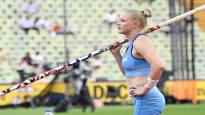Wilma Murro and the javelin men have a realistic chance to return Finnish athletics to World Cup or Olympic medals after an eight-year hiatus, writes Urheilu’s Joel Sippola.
The Finnish athletics season was undeniably a success by many measures. The highlight was, of course, the European Championships in Munich, where Finland won a whopping four medals and two European championships.
When this is added to Finland’s first medal won by a non-javelin man in 16 years and the first medal won by a Finnish woman since the 2022 Munich Games, we are talking about a truly blue-and-white top season.
It also happened behind the sharp tip, which raises promises of even better value race success in the future.
In the European Championships, Finland achieved the most points (43) since the 2002 Games (46). There were nine athletes in the points, i.e. among the top eight. Before that, the last time it had been better was in the 2002 European Championships, where 11 athletes reached the points.
The World Championships in Oregon were also a clear sign of the development of Finnish athletics. There were six Finns in the World Cup final, which was the most at the World Cup or Olympic level since 2005. At that time, there were nine athletes who made it to the final. There were also the highest number of points in 16 years.
The youth value competitions, on the other hand, followed the trend of recent years. In continuation of last year’s record four youth world championships and five medals, Finland received one gold and two silver medals at this year’s under-20 world championships. Finland, on the other hand, received five medals from the European Championships for under-18s.
When, in addition to these, the three medals of the 2021 European Championships are added to the list, Finnish athletics has reached a new level after many challenging years. The next challenge is to reach medals at the World Cup and Olympic level.
With such performances, the Finns are either caught or fighting for medals also at the global level. The story continues after the videos.
World Cup medal chances
In the 2000s, Finland has reached World Cup or Olympic medals only nine times. A shot putter has been able to do that Arsi Harjua javelin thrower Aki Parviainenlong jumper Tommi Eviläa javelin thrower Tero Pitkämäki and a javelin thrower Antti Ruuskanen. Pitkämäki has been able to do it four times and Harju twice. Finland’s previous global medal is Pitkämäki’s World Championship bronze from Beijing 2015.
In the World Championships, the level is still a few degrees harder than in the European Championships. Although Finland does not yet have a consistent global cannon like Pitkämäki, the starting points for next year’s World Championships in Budapest are the most promising in a long time.
Wilma Murto showed with his top jump in the European Championship final that he has a realistic shot at fighting for World Cup and Olympic medals in the near future. Women’s pole vaulting has been 12 times in the World Championships and six times in the Olympics.
The 485 bended by Murro on his second attempt has been enough for medals in all the games in question, although in a few games the bronze has been required to exceed that height on the first attempt.
Thinking about next year’s World Championships, in addition to Murro, Finland’s other most realistic medal hopes are the javelin thrower Oliver Helander and Lassi Etelätalo.
Of course, health is a big question mark for Helander, but 89.83 is a result of the class that you can’t ignore Helander from speculation when he’s in it. Excellent in value competitions Lassi Etelätalo on the other hand, they are strong, especially when the world champions don’t throw around 90 meters.
Triple Jumper Kristiina Mäkelä does not yet have medal hopes at the World Championship level, but with the record 14.64 he jumped in the European Championship final, he is not very far from that. In the two previous World Championships, bronze was taken with results of 14.73 and 14.72. In Tokyo, 14.87 was required for a medal.
Thinking about the global value competitions in the next few years, it is worth keeping an eye on 19-year-olds Silja from Koso and Saga of Vanni. The bronze readings of around 75 meters are still too much compared to Kosonen’s mouka record and basic level, but the young athlete has the potential to develop rapidly in the next few years. Vanninen is in a similar phase. The very talented number seven player, if he stays healthy, can be in a very good point position very soon.
Whether there will be World Cup medals next year or not, Finnish athletics has in any case several opportunities for the continuation of the success addiction. In the winter in Istanbul, there is a fight for EC indoor medals, which are completely realistic, especially for Murro and the female triple jumpers.
The under-23 European Championship held in Espoo in the summer will bring its own spice to next year. Vanninen, Kosonen, Topias Laine and Eemil Helander.
1. Arsi Harju, kuula. Sydney Olympics 2000.
2. Aki Parviainen, javelin. World Championships in Edmonton 2001.
3. Ridge. World Championships in Edmonton 2001.
3. Tommi Evilä, height. Helsinki World Championships 2005.
1. Tero Pitkämäki, spear. Osaka WC 2007.
3. Pitkämäki. Beijing Olympics 2008.
2. Antti Ruuskanen, javelin. London Olympics 2012.
2. Pitkämäki. Moscow World Cup 2013.
3. Pitkämäki. Beijing World Championships 2015.
